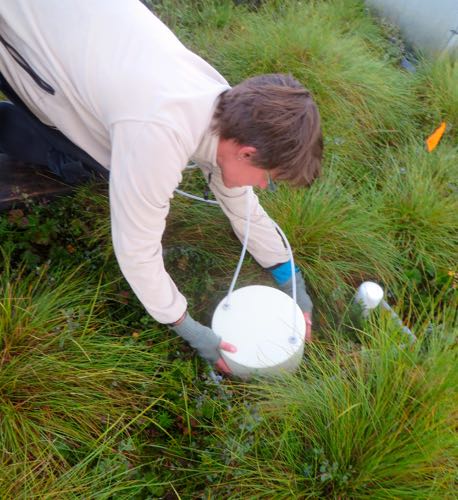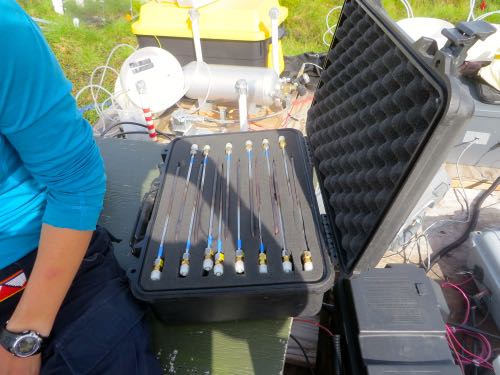Capturing Tundra Soil Respiration
Another way to estimate how much carbon dioxide is being respired in response to a warming tundra is to capture the gas emitted from the soil environment and analyze it for radioactive carbon or 14C.
Refresher on Radioactive Carbon Dating
14C is an radioactive isotope of carbon. A radioactive isotope means that the isotope is unstable and will eventually decay into another element. Radioactive carbon has a half life of 5,700 years, which means that in 5,700 years only half of the original amount of C14 will still exist as C14. Scientists use radioactive decay to find out how old something is. Archeologists might use it to learn how old a bone is. Scientists who study climate change use radioactive carbon to date the organic matter that is decomposing in the tundra soil. This short video can give you some background on how C14 dating works:
Due to the frozen nature of the arctic soils, decomposition occurs slowly and therefore the carbon dioxide released from cellular respiration is not abundant. When organisms die in the arctic ecosystem, their bodies remain mostly un-decomposed adding to the layers of frozen tundra soil.
However, since the climate of the arctic is warming, the organic matter in the tundra that has been accumulating over millennia, will thaw and become available for decomposition, releasing ever more carbon dioxide into the atmosphere. But not all the CO2 that is emitted from the tundra soil is "old" carbon, some of it is simply coming from the decay of recently dead organisms, organisms like plants that have recently taken CO2 out of the atmosphere. Dr. Edward Schuur and his CiPHER team are quantifying how much of the respired carbon dioxide is "new" carbon and how much is "old" carbon. If a lot of the carbon collected from tundra respiration is found to be "old" carbon, then this suggests that with a warming atmosphere, the tundra may be poised to release even more carbon into the atmosphere, a billion tons of CO2/year. To learn more about this: http://www.nature.com/news/2009/090527/full/news.2009.513.html
14C Sampling Protocol
Marguerite Mauritz has been collecting tundra gas samples for 14C analysis for several years now. She is teaching Emily Romano the protocol and passing on her knowledge.
 Marguerite Teaching Emily Romano how to capture 14C gas
Marguerite Teaching Emily Romano how to capture 14C gas
Marguerite Mauritz and Emily Romano will collect 42 gas samples for radiocarbon analysis for the CiPEHR and DRYPHER sites. The first step is to prepare the trapping systems and the traps the day before collection.
 Prepping the C14 gas Trapping System
Prepping the C14 gas Trapping System
The sample collection may take several weeks to complete as it requires that the weather cooperate. It must be dry and not windy, conditions that are not easy to come by this season. To optimize the probability of good weather, we must rise very early and get to the site before 7:00 am. The fog covers the valleys and a thick dew has collected on the plexiglass chambers.
 Early Morning at CiPEHR
Early Morning at CiPEHR
 Dew Collecting on Chambers
Dew Collecting on Chambers
Conditions are good this morning and no wind disturbs the site, so Marguerite begins by placing a collection chamber over the tundra soil.
 This is the Tundra Sample Site
This is the Tundra Sample Site
 Setting Collection Chamber
Setting Collection Chamber
She then attaches the chamber to the trapping system, and "scrubs" the covered tundra air to remove air that may contain carbon dioxide that has not originated from the soil respiration.
 Scrubbing System for the C14 gas capture
Scrubbing System for the C14 gas capture
In addition to the scrubbing, Marguerite checks the flow rate several times.
 Marguerite Mauritz Checking Flow Rate
Marguerite Mauritz Checking Flow Rate
Once the flow rate is consistent and within an acceptable range, the "traps" are connected to the trapping system.
 This is what a Gas Trapping System looks like
This is what a Gas Trapping System looks like
The traps labelled with location data, are stored and later sent to the UC Irvine lab for 14C analysis.
 Traps Stored for Later Analysis
Traps Stored for Later Analysis
Another round of collection happened again this morning. However, by 10 am, the wind began to pick up and we decided to check with the HOBO weather station on site to determine if we needed to stop. Sure enough, the HOBO captured a wind speed just shy of the threshold 3 m/sec or 7 m/hr. We decided to finish the sampling another day.
 Checking the wind speed at the HOBO Weather Station at the Gradient Site
Checking the wind speed at the HOBO Weather Station at the Gradient Site

Comments